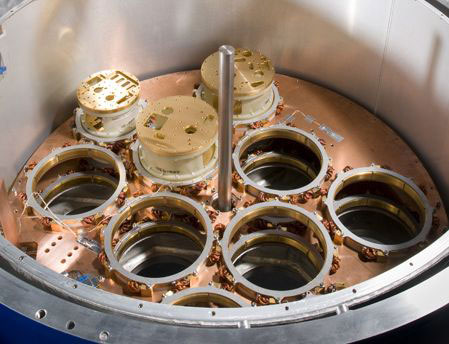| Feb 20, 2013 |
Space provides new frontier for new cryocooler coatings
|
|
(Nanowerk News) Experts have developed a new coating for space satellite cryocoolers - the specialist devices that regulate their temperature and enable them to function in space.
|
|
The University has been working with the Space Science Technology Department of Rutherford Appleton Laboratory (RAL) after finding that the component coatings created by the University team are better at maintaining the optimum temperature of satellite systems on missions to observe the solar system and beyond.
|
 |
| cryocooler
|
|
And they are now set to be used in a space observatory to help characterise the physics and chemistry of planetary atmospheres beyond the known solar system.
|
|
It means the University can help support the £9.1bn space industry, currently experiencing an annual growth rate of 7.5 per cent.
|
|
Dr Martin Crook from RAL said: “Cryocoolers are a key enabling technology for space-based science and astronomy and Rutherford Appleton Laboratory are world leaders in this technology.
|
|
"For some years we have been aware of the potential for rare-earth coatings to enhance the performance of our coolers but despite numerous attempts were not able to implement a flight-worthy solution.
|
|
"Now Sheffield Hallam has developed an excellent coating suitable for a flight qualification programme.
|
|
"Directly through that work, our Stirling cycle cryocooler has demonstrated a clear advantage over other technologies at this temperature, and is the first choice for scientists currently entering instrument proposals for forthcoming missions such as EChO, a space-based observatory to characterise the physics and chemistry of exoplanet atmospheres.”
|
|
Professor Arutiun Ehiasarian and his team at the University's Nanotechnology Centre for Plasma Vapour Deposition has developed a new coating technology called High Power Impulse Magnetron Sputtering (HIPIMS) for the deposition of very dense and highly adherent metal and ceramic materials.
|
|
The team is a world leader in HIPIMS technology and has developed new applications for space, manufacturing, automotive, semiconductor and photovoltaic sectors.
|
|
Professor Ehiasarian said: "The satellite is going to be in orbit around the Earth and will search for inhabitable planets beyond the known solar system by looking at the atmosphere of planets orbiting other stars.
|
|
"The goal is to find planets that could support human or extra-terrestrial life.
|
|
"Cryocooling of space satellites is crucial due to the low operating temperature of on-board detectors that are used to collect data from distant celestial objects and the Earth.
|
|
"Low temperatures ensure higher sensitivity due to reduced thermal noise and better image quality due to reduced thermal vibrations in optics. Additionally, due to the low thermal conductivity of the vacuum operating environment there is a necessity to cool vital systems while they are in space in order to avoid temperature build-up over years of use.
|
|
"The increasing complexity of satellites demands improvements in cooling efficiency and Sheffield Hallam is expertly placed to carry out this work."
|

